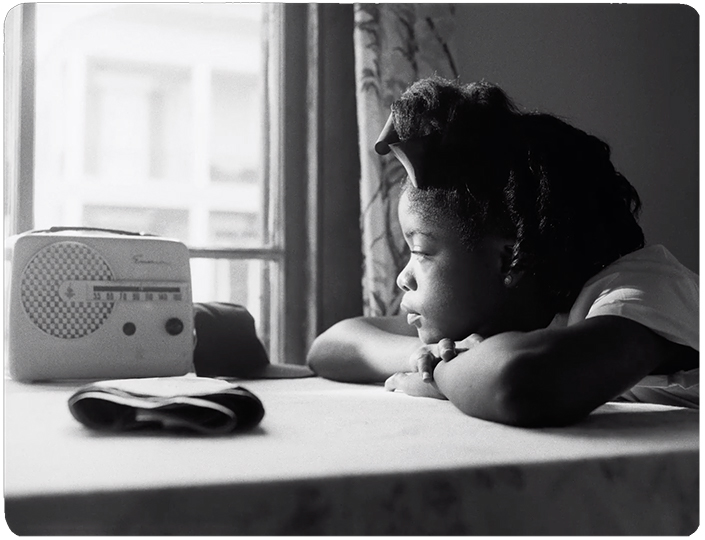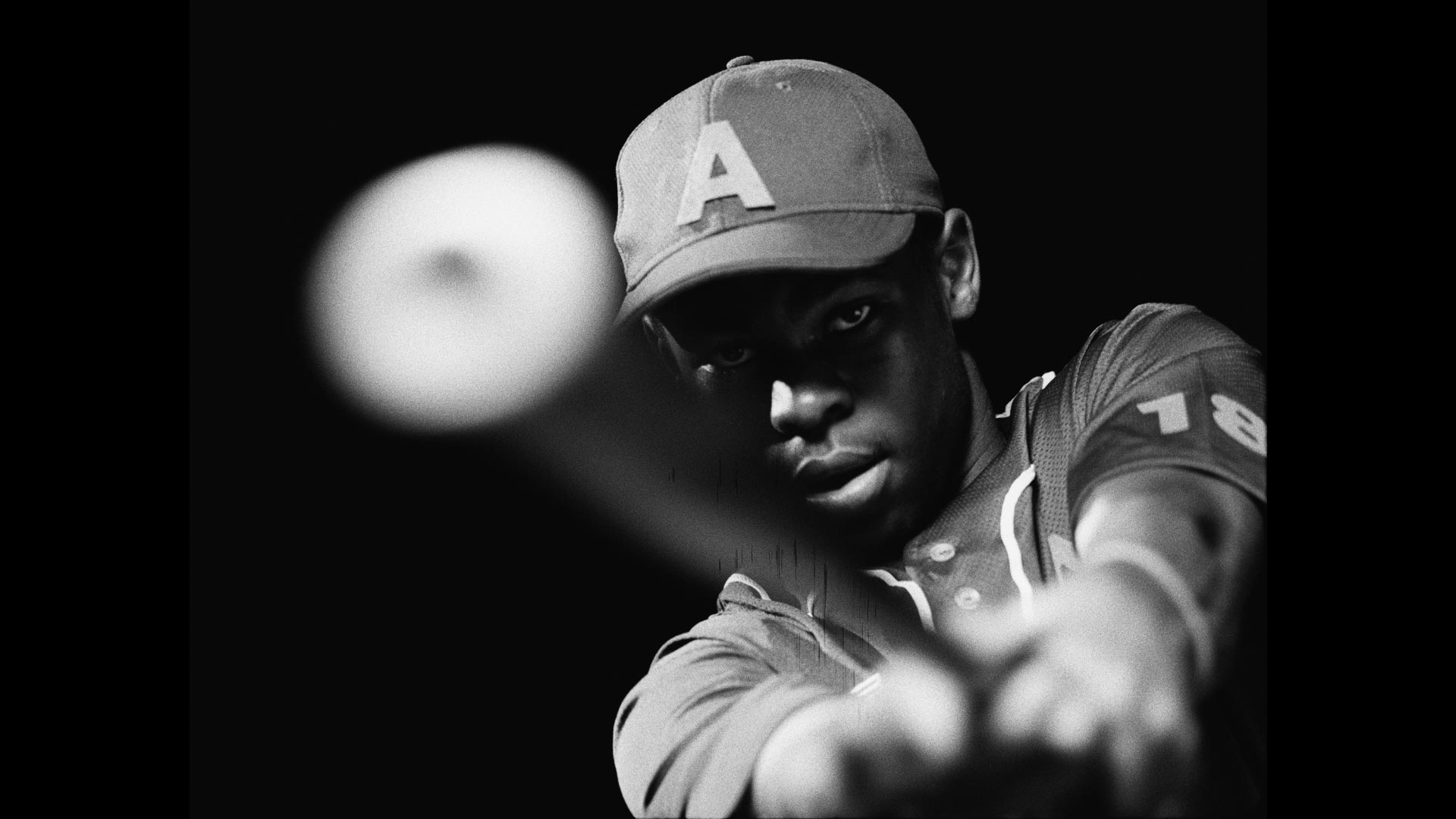An Essay Excerpt from the Garrett Bradley: American Rhapsody Catalog
Award-winning filmmaker and artist Garrett Bradley is soon to be the newest artist featured at the Momentary. Her short films and feature-length projects have been exhibited internationally at museums and festivals, and she won the 2020 US Documentary Directing Award by the Sundance Film Festival for her film Time, becoming the first African American woman to win in the category, and the 2020 Gotham Independent Film Award for Best Documentary.
Garrett Bradley: American Rhapsody, the exhibition opening at the Momentary on July 3, features a selection of three recent works by the artist—two single-channel videos and a multi-channel video installation—America (2019), AKA (2019), and Alone (2017).
In America, a multi-channel video installation, Bradley constructs a visual archive of early African American cinema, mixing found footage from Lime Kiln Club Field Day (the earliest-known film with an all-Black cast) and newly shot performances by non-trained actors of present-day slices of life. These pleasant visuals challenge its audience to consider what it might mean to see Black representation through a lens that privileges depictions of pleasure over spectacles of pain.
In the following excerpt, taken from the essay “America: In and Out of Frame” by Rebecca Matalon, curator, Contemporary Arts Museum Houston, found in the Garrett Bradley: American Rhapsody catalog, learn more about Bradley’s work and the inspiration behind it before seeing it in the Momentary galleries.
An Excerpt from “America: In and Out of Frame” by Rebecca Matalon

In 2013, a survey conducted by the Library of Congress estimated that 70 percent of silent films made between 1912 and 1929 have been lost.[1] A year later, in 2014, The Museum of Modern Art in New York announced the restoration and release of what they believed to be—after a decade of research—the first surviving film to feature an all-Black cast and integrated production and directorial team. The film, belatedly titled Lime Kiln Club Field Day or Bert Williams Lime Kiln Club Field Day, was made in 1913 and—following the 1939 acquisition of a trove of unprinted negatives from the once prolific Biograph Company by film curator Iris Barry—sat as a set of seven reels in MoMA’s film storage facilities.[2] Abandoned as a series of unassembled rushes that include multiple takes as well as behind-the-scenes footage of cast and crew, Lime Kiln Club Field Day stars famed Caribbean American actor and entertainer Bert Williams (1874–1922), as he competes for the attentions and affections of the film’s female lead, Odessa Warren Grey (1883–1960) while they spend a day of leisure and love at the fairgrounds. Through a series of scenes depicting domestic life, a social club, a parade, a carousel ride, and a cakewalk—believed to be the most substantial early recording of the pre-civil war Black vernacular dance form—Lime Kiln presents a rare and atypical picture of Black life during Jim Crow segregation. The film is remarkable for its depictions of middle-class Black life, joy, and intimacy in a period that also saw the widespread release of films, like The Birth of a Nation, that so meticulously set their sights on cutting such life down.
The significance of the release of Lime Kiln, coupled with the Library of Congress’ estimation of missing films, was not lost on Garrett Bradley, an artist primarily working in film. Schooled in the history of film, Bradley took the twinned discoveries at face value: If the majority of silent-era films no longer exist, and if one had surfaced that so diverged from what was thought to be known about filmic representations of Black life in early twentieth-century America, perhaps there had been others like it? Bradley began a deep dive into the holdings of the Black Film Archive at the Library of Congress, spending days watching Lime Kiln as well as a host of early films featuring black actors such as Oscar Micheaux’s Within Our Gates (1919), Richard E. Norman’s The Flying Ace (1928), and Harry A. Gant’s By Right of Birth (1921), a film made in direct response to The Birth of a Nation and produced by the first Black-owned and operated production company, the Lincoln Motion Picture Group, which was active from 1916 to 1923.
Spurred by her research, Bradley set towards imagining an alternate history of Black visuality. The resulting work, America (2019)—a multi-channel video installation—was made over the course of six years. America takes shape as a series of 12 vignettes loosely inspired by 12 historical and cultural events and individuals, beginning in 1915 with the release of The Birth of a Nation and ending in 1929, when Bessie Coleman, an African American woman, became the first American to receive an international pilot’s license. Taking the form of a large-scale multi-channel video installation, America reveals Bradley as an artist intent on troubling traditional distinctions between narrative and documentary cinema, embracing modes of working and representing history that resist linear chronologies and, instead, foreground fragmentary and affective experiences of time.

As in other of Bradley’s works, such as the recent experimental short AKA (2019), also included in this exhibition, America features performances by non-trained actors sourced from the artist’s New Orleans community and shot in and around the city.[3] America’s two lead actors, choreographers and dancers Donna Crump and Edward Spotts, appear throughout a number of the vignettes, which, despite being premised on individual events, are seamlessly interwoven in the film. In Crump’s first appearance, in the 1915 scene, we find her slowly approaching a large tree at the base of which sits a white man adorned in a Klansman’s cloak. She tears his cloak to shreds, a fragment of which flies away, initiating the propulsive movement that characterizes much of America. Other scenes imaginatively and abstractly unfold: the founding of the Boy Scouts of America, a baptism, the domestic use of the first commercially available radio sets, the crash of a meteorite, the awarding of the first Olympic gold medal to an African American woman, and the performance of the first symphony by an African American woman, among many others.
Shot in black-and-white using 35mm film, America is absent of internal dialogue, its story told through the locations, scenery, props, costumes, choreographed movements of its actors and cameras, and layering and splicing of newly shot footage with clips and stills from Lime Kiln. Its sound is a mix of Foley (everyday sounds added in post-production) and an ambient score by Trevor Mathison of the Black Audio Film Collective. Together these tracks produce a rhythmic and rhapsodic soundtrack marked, at times, by anachronistic ruptures—such as a police siren or a man’s voice, nearly unintelligible and penetratingly deep, as he periodically riffs on the meaning of “America.”
America opens with images of Williams—in the form of a professional portrait and in film and production stills of the actor on set. Additional film stills of Warren Grey and other cast members flash on screen, as well as a sequence in which we see Lime Kiln’s two leads smiling and laughing as they ride a carousel. Opening with the archival footage, Bradley positions Lime Kiln and, perhaps more precisely, the history of film at the center of a contemporary conversation on the racial and cultural politics of everyday life. Bradley’s use of archival materials, part of a long legacy of avant-garde filmmaking, functions to call into question the archive’s irrefutability, instead asserting the nature of history and knowledge as contextual and ever-changing. Her juxtaposition of archival footage with newly shot performances and the soundtrack added in during editing is significant as it serves to both tether America to a specific moment in history and reframe this history from the vantage point of the present.
***

To read the rest of the essay, pick up a copy of the Garrett Bradley: American Rhapsody catalog, on sale at the Momentary Shop!
References:
- See David Pierce, The Survival of American Silent Feature Films: 1912-1929 Washington, DC: Council on Library and Information Resources and The Library of Congress, 2013. As the study shows, early film stock, made of nitrate, tended to disintegrate and was highly flammable. Coupled with a general negligence towards preservation, the film industry’s tendency to destroy early prints resulted in the loss of the majority of silent-era films.
- See Felicia R. Lee, “Coming Soon, a Century Late: A Black Film Gem,” The New York Times, September 20, 2014, https://www.nytimes.com/2014/09/21nyregion/coming-soon-a-century-late-a-black-film-gem.html.
- For a consideration of the role New Orleans plays in Bradley’s work, as well as her extended engagement with the communities and individuals she seeks to represent in her film-based work, see “In Conversation: Garrett Bradley and Huey Copeland.”



